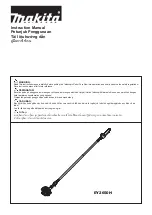
5.
Place the workpiece flat on the table with one edge
securely against the fence (14). If the board is warped,
place the convex side against the fence (14). If the
concave side is placed against the fence, the board could
break and jam the blade.
6.
When cutting long pieces of timber, support the
opposite end of the timber with side support bars, a
roller stand or a work surface that is level with the saw
table.
7.
Before turning on the saw, perform a dry run of the
cutting operation to check that there are no problems
such as a clamp interfering with the cutting action.
8.
Hold the operating handle (5) firmly and squeeze the
release latch
(30)
. Allow the blade to reach maximum
speed and slowly lower the blade into and through the
workpiece.
9. Release the switch trigger (19) and allow the saw blade
to stop rotating before raising the blade out of the
workpiece. Wait until the blade stops before removing
the workpiece.
BEVEL CUT
If possible, always use a clamping device such as a
‘
G"
clamp to secure your workpiece.
When cutting your workpiece, keep your hands well
away from the blade area.
Do not remove a cut-off piece on the right-hand side of
the blade using your left hand.
A bevel cut is made by cutting across the grain of the
workpiece with the blade angled to the fence and mitre
table. The mitre table is set at the zero degree position
and the blade set at an angle between 0
°
and 45
°
.
1.
Pull on the release knob (4) and lift the saw arm to its
full height.
2.
Loosen the mitre locks (20) and lifting up the mitre
latch (21).
3.
Rotate the mitre table (16) until the pointer aligns with
zero on the mitre scale (17).
4.
Release mitre latch (21) and retighten the mitre locks
(20).
5.
Loosen the bevel lock (12) and move the saw arm (3)
to the left to the desired bevel angle (between 0
°
and
45
°
). Tighten the bevel lock (12).
6.
Place the workpiece flat on the table with one edge
securely against the fence (14). If the board is warped,
place the convex side against the fence. If the concave
side is placed against the fence, the board could break
and jam the blade.
7.
When cutting long pieces of timber, support the
opposite end of the timber with side support bars, a
roller stand or a work surface that is level with the saw
table.
8.
Before turning on the saw, perform a dry run of the
cutting operation to check that there are no problems
such as a clamp interfering with the cutting action.
9.
Hold the operating handle (5) firmly and squeeze the
release latch
(30)
. Allow the blade to reach maximum
speed and slowly lower the blade into and through the
workpiece.
10.
Release the switch trigger (19) and allow the saw
blade to stop rotating before raising the blade out of the
workpiece. Wait until the blade stops before removing
the workpiece.
ATTACH FENCE
1. For cutting safety always use two attach fence.
2. If use bevel cut , drag out the attach fence. The
attach fence distance moving parts about 3-8mm at
any times.
COMPOUND MITRE CUT
If possible, always use a clamping device such as a
‘
G"
clamp to secure your workpiece.
When cutting your workpiece, keep your hands well
away from the blade area.
Do not remove a cut-off piece on the right-hand side of
the blade using your left hand.
A compound mitre cut involves using a mitre angle and a
bevel angle at the same time. It is used in making picture
frames, to cut mouldings, making boxes with sloping
sides and for roof framing. Always make a test cut on a
piece of scrap wood before cutting into the good
material.
1.
Pull on the release knob (4) and lift the saw arm to its
full height.
2.
Loosen the mitre locks (20) and lifting up the mitre
latch (21) ..
3.
Rotate the mitre table (16) until the pointer aligns with
the desired angle on the mitre scale (17).
4.
Release mitre latch (21) and retighten the mitre locks
(20).
5.
Loosen the bevel lock (12) and move the saw arm (3)
to the left to the desired bevel angle (between 0
°
and
45
°
). Tighten the bevel lock (12).
6.
Place the workpiece flat on the table with one edge
securely against the fence (14). If the board is warped,
place the convex side against the fence. If the concave
side is placed against the fence, the board could break
and jam the blade.
7.
When cutting long pieces of timber, support the
opposite end of the timber with the side support bars, a
Содержание CT5305
Страница 14: ......
































